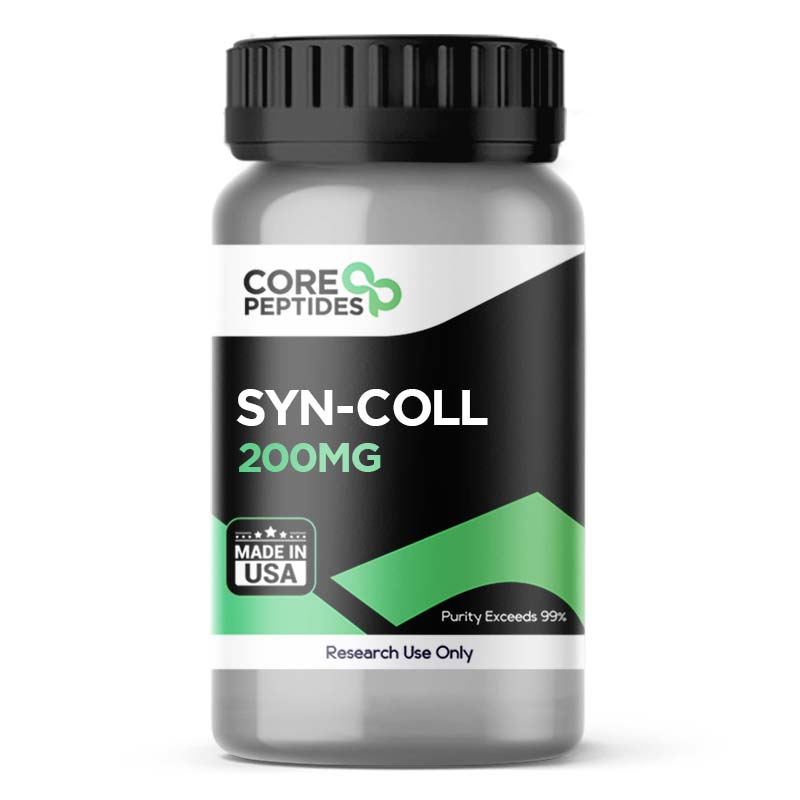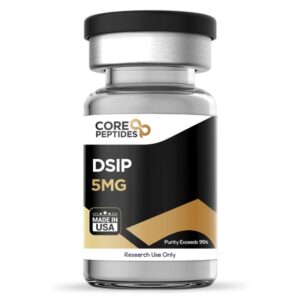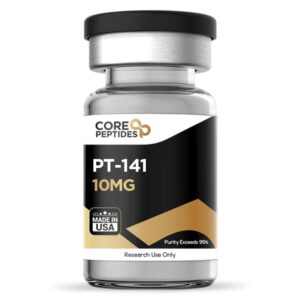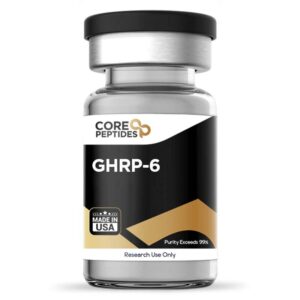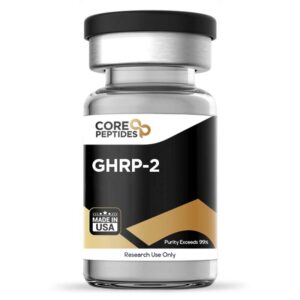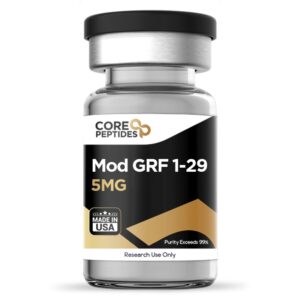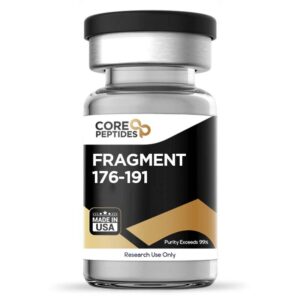Syn-Coll (Palmitoyl Tripeptide-5) (200mg)
$176.00
Size: 200mg
Contents: Syn-COLL
Form: Lyophilized powder
Purity: >99%
SKU: P-SYN-COLL
FREE Shipping on $200+ orders
Discount per Quantity
| Quantity | Discount | Price |
|---|---|---|
| 5 - 8 | 5% | $167.20 |
| 9 + | 10% | $158.40 |
Syn-Coll Peptide
Syn-Coll is a synthetic peptide compound, also known as palmitoyl tripeptide-5. It was designed to mimic the activity of thrombospondin-1 (TSP-1), a natural extracellular matrix protein that apparently stimulates transforming growth factor beta (TGF-β). TGF-β is a crucial growth factor that plays a vital role in maintaining skin integrity and stimulating the postnatal development of skin structures by promoting collagen synthesis.
The short sequence Lys-Arg-Phe-Lys of TSP-1 is considered responsible for TGF-β stimulation.(1) Syn-Coll has the sequence of Palmitoyl-Lys-Val-Lys, and scientists report that it may exert similar action on TGF-β. As a result, animal models and dermal fibroblasts cell culture tests suggest it may stimulate collagen production. More specifically, Syn-Coll may increase the production of Type I and Type III collagen by dermal fibroblasts via stimulating TGF-β activity.
Furthermore, Syn-Coll has been extensively studied in animal models and experiments, which all generally hypothesize that it exhibits some potential to increase collagen synthesis but also prevent collagen degradation. Syn-Coll may prevent collagen breakdown by inhibiting the activity of matrix metalloproteinases (MMPs) such as MMP1 and MMP3.
Chemical Makeup
Molecular Formula: C33H65N5O5
Molecular Weight: 611.9 g/mol
Other Known Titles: Palmitoyl-lysyl-valyl-lysine, Palmitoyl Tripeptide-5
Research and Clinical Studies
Syn-Coll Peptide and Collagen Synthesis
Collagen is a major component of the extracellular matrix, the network of proteins and fibers that comprise dermal connective tissue.
Recent studies have indicated that Syn-Coll may stimulate collagen synthesis. This synthetic peptide is believed to work by mimicking the activity of TSP-1 to activate the growth factor TGF-β. More specifically, Syn-Coll may work by mimicking part of the sequence of TSP-1.(2)
TGF-β is a crucial growth factor that has been suggested to play an important role in regulating collagen production. Studies have suggested that Syn-Coll works by activating latent TGF-β, thereby increasing the production of type I and type III collagen by dermal fibroblasts. As a result, scientists report that activating TGF-β "causes a persistent increase in steady-state amounts of type I and type III collagen and fibronectin mRNAs in normal [...] dermal fibroblasts."(3)
Trials have also indicated that Syn-Coll may increase type 1 collagen synthesis via TGF-β to a greater degree than other peptides, such as palmitoyl pentapeptide.(4) The researchers posited that "Palmitoyl tripeptide-5 also known as Syn-Coll, increases collagen 1 production via TGF-b reportedly 60% more effective than palmitoyl pentapeptide."
Syn-Coll Peptide and Collagen Breakdown
Matrix metalloproteinases (MMPs) are a group of enzymes involved in the degradation of extracellular matrix proteins, including collagen. Scientists consider MMPs to be typically produced by dermal cells, such as fibroblasts, and are involved in tissue remodeling and maintaining the extracellular matrix. However, they further posit when MMPs are overproduced or become dysregulated, they can contribute to dermal collagen breakdown. For example, MMP-1 is considered to be an enzyme that specifically degrades type I collagen.
Fibroblasts produce MMP-1, and its activity may be increased by factors such as UV radiation, inflammation, and oxidative stress. Another member of the MMPs is MMP-3, and considered capable of cleaving a wide range of extracellular matrix proteins, including collagens, laminin, fibronectin, proteoglycans, and elastin. It may be particularly active at degrading type II collagen, the main structural component of cartilage. MMP-3 has also been implicated in the degradation of other collagens, such as type III collagen, which is abundant in the skin and blood vessels.
Syn-Coll (Palmitoyl tripeptide-5) seems to decrease collagen breakdown by inhibiting matrix metalloproteinases degrading collagen. More specifically, studies suggest that Syn-Coll (palmitoyl tripeptide-5) may prevent collagen breakdown by interfering with MMP1 and MMP3 collagen degradation.(5)
Syn-Coll Peptide and Anti-Aging
Studies have suggested that Syn-Coll may reduce the appearance of wrinkles to a much greater extent than a placebo.(6) The scientists reported that "formulation demonstrated a dose-dependent wrinkle reduction, measured by PRIMOS surface topography." Ultimately, they concluded that Syn-Coll (palmitoyl tripeptide-5) might exhibit roughly 3.5 times the potential to reduce the appearance of wrinkles than the placebo. One study in 60 test subjects that lasted 84 days reported that Syn-Coll twice daily suggested it may exhibit anti-wrinkle potential and reduce skin roughness better than control groups, placebo, and other peptides.(7) The peptide appeared to reduce wrinkle parameters by 12%.
Besides its potential on collagen synthesis and degradation, scientists suggest that Syn-Coll may exert possible anti-wrinkle action through other mechanisms.(8) These include supporting the skin's barrier function by possibly preventing water loss from the skin's surface. This can help to maintain optimal hydration levels in the skin. Furthermore, Syn-Coll may act as a humectant, which can help absorb and retain water in the skin. It may also increase skin surface lipids and act as an emollient, providing partial occlusion, lubrication, and moisturization to the skin.
In addition, Syn-Coll may also be modified by adding an L-ascorbate moiety (AA) at the C-terminus (Pal-KVK-AA), which may have a depigmentation impact. Studies have suggested that this conjugation may inhibit melanin synthesis.(9) By blocking melanin production, this modified version of Syn-Coll may help reduce hyperpigmentation caused by photoaging, UV light, oxidative stress, and other factors.
Syn-Coll peptide is available for research and laboratory purposes only. Please review and adhere to our Terms and Conditions before ordering.
References:
- Murphy-Ullrich, J. E., & Poczatek, M. (2000). Activation of latent TGF-beta by thrombospondin-1: mechanisms and physiology. Cytokine & growth factor reviews, 11(1-2), 59–69. https://doi.org/10.1016/s1359-6101(99)00029-5
- Trookman, N. S., Rizer, R. L., Ford, R., Ho, E., & Gotz, V. (2009). Immediate and Long-term Clinical Benefits of a Treatment for Facial Lines and Wrinkles. The Journal of clinical and aesthetic dermatology, 2(3), 38–43.
- Varga, J., Rosenbloom, J., & Jimenez, S. A. (1987). Transforming growth factor beta (TGF beta) causes a persistent increase in steady-state amounts of type I and type III collagen and fibronectin mRNAs in normal human dermal fibroblasts. The Biochemical journal, 247(3), 597–604. https://doi.org/10.1042/bj2470597
- Bucay, V. W., & Day, D. (2013). Adjunctive skin care of the brow and periorbital region. Clinics in plastic surgery, 40(1), 225–236. https://doi.org/10.1016/j.cps.2012.09.003
- Errante, F., Ledwoń, P., Latajka, R., Rovero, P., & Papini, A. M. (2020). Cosmeceutical Peptides in the Framework of Sustainable Wellness Economy. Frontiers in chemistry, 8, 572923. https://doi.org/10.3389/fchem.2020.572923
- Gorouhi, F., & Maibach, H. I. (2009). Role of peptides in preventing or treating aged skin. International journal of cosmetic science, 31(5), 327–345. https://doi.org/10.1111/j.1468-2494.2009.00490.x
- Schneider, A. L. (2010). Evaluation of the penetration and efficacy of anti-aging compounds (Doctoral dissertation, Monash University).
- Kim, H. M., An, H. S., Bae, J. S., Kim, J. Y., Choi, C. H., Kim, J. Y., Lim, J. H., Choi, J. H., Song, H., Moon, S. H., Park, Y. J., Chang, S. J., & Choi, S. Y. (2017). Effects of palmitoyl-KVK-L-ascorbic acid on skin wrinkles and pigmentation. Archives of dermatological research, 309(5), 397–402. https://doi.org/10.1007/s00403-017-1731-6
